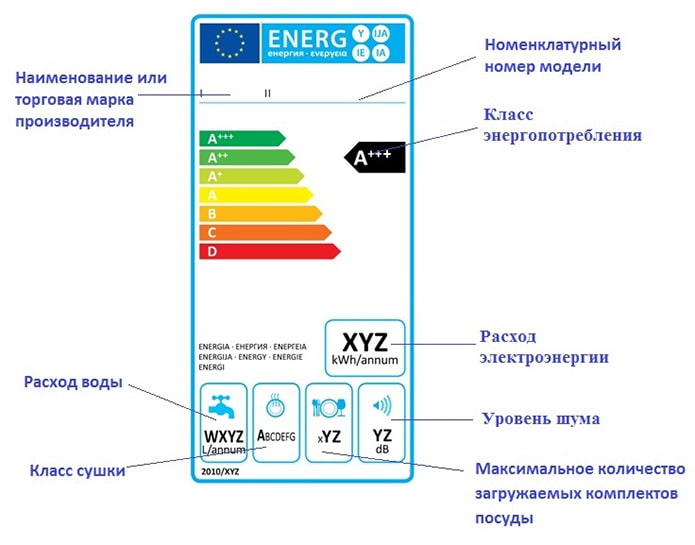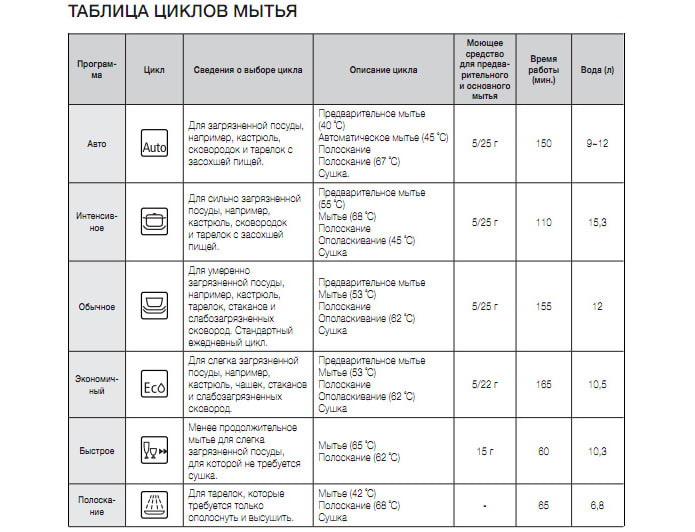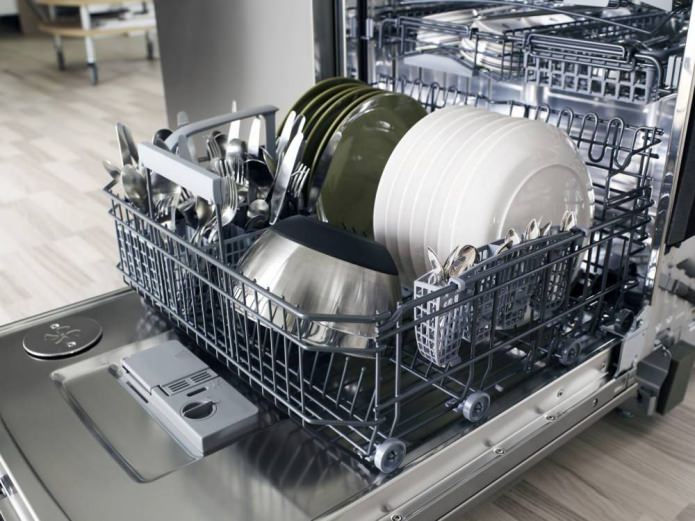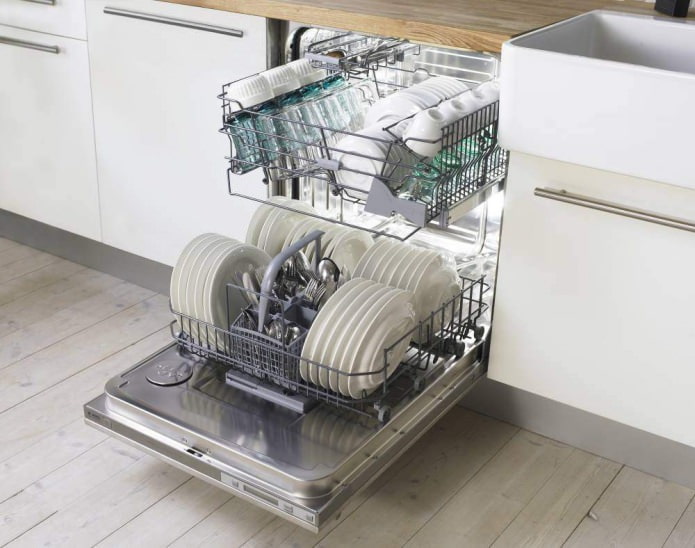Dishwasher benefits
- Significant reduction in water consumption (up to 8000 liters per year).
- The ability to use only cold water, which is especially important in the absence of hot water supply.
- The contact of the skin of the hands with detergents is completely excluded, which allows the use of stronger formulations than with manual washing.
- All types of dishwashers provide significantly more efficient rinsing than is possible with washing dishes by hand, due to the use of hot water.
- Finally, the biggest plus is a decrease in the time for washing dishes, in fact, you only have to load dirty dishes into it, select a program, and then get a clean one - the machine will do the rest.
There are many factors to consider when choosing a dishwasher. Not only sizes, but also functions and modes of dishwashers.
Dishwasher types
The main parameter by which dishwashers are compared is the number of "sets of dishes" that the machine washes in one cycle. The term "set" includes three plates, the same number of spoons, a knife, a fork and a cup and saucer. Of course, this concept is conditional, and is used precisely in order to be able to compare the performance of different dishwashers.
By size the division is carried out into:
- desktop;
- narrow;
- oversized
First type - the most compact. The width and length of such a machine does not exceed 55 cm, the height is 45 cm. It can be placed on the table, or it can be hidden under the sink if there is not enough space to install a large dishwasher. This option is suitable for a small family, as it cleans no more than five dish sets in one cycle.
Second type has a standard height and depth (85 and 60 cm), but at the same time a reduced width - 45 cm. Finding a place for such a machine is easier, suitable for a family of three to five people.
Third type - the largest, 85x60x60 - these are the dimensions of a full-size dishwasher that processes up to 15 sets of dishes at a time. It makes sense to buy such a machine if you have a really big family and you really love to cook.
When choosing a dishwasher, you also need to immediately imagine whether it will stand alone, or it can be built into a kitchen set. According to the way in which these units are installed, they are divided into two types, one of which, in turn, is subdivided into two more:
- free-standing,
- built-in (in whole or in part).
Full integration will ensure the "invisibility" of the car in the interior, while partial integration will allow easy access to the control panel.

Dishwasher classes
How efficiently a dishwasher works is judged by its class.
Work quality class. Seven classes mean seven levels of quality of work and are denoted by Latin letters from A to G. A corresponds to the highest quality, and, as a consequence, the maximum price.
A-class machines use less water for washing dishes than lower class machines. Accordingly, they also need less detergent and special rehydration salts.Thus, each cycle requires fewer consumables and is generally cheaper to operate. For comparison, we will give the figures: in class A, 15 liters of water are spent on the working cycle, in class E - up to 25.
Energy class. The ability of a dishwasher to save energy is also assessed by classes, which are the same as efficiency classes, and they are designated in the same way.
Drying class. The types of dishwashers are also distinguished by the drying class, which can be carried out in different ways:
- condensation;
- ventilation.
And in this case, the class is determined by Latin letters from the beginning of the alphabet, and decreases towards the end. The most efficient drying method is ventilation using heated air. After the end of the process, you take out the dishes not only dry, but also warm.
Noise level. A very important characteristic of any household appliance is the noise it produces during operation. On the case of any household appliance, the average noise level in decibels is usually indicated, which you need to focus on. A quiet dishwasher is one that makes noise in the range of 47 to 57 dB.

Dishwasher functions
Among the many different functions of dishwashers, it is not so easy to determine what is really needed and what is a marketing ploy to improve sales. Let's try to figure it out in order to understand what you should pay special attention to when choosing a model.
- Basket. How convenient it will be to use the machine depends on the arrangement of the place for loading dishes. The dishwasher may be able to tilt the basket to increase the efficiency of the dishwashing. A variety of holders, removable trays and other devices will increase the convenience of use, and, in addition, will contribute to the better preservation of your dishes, since this parameter largely depends on the reliability of fixing the devices. The basket, the holders of which can be adjusted in height and width, is easy to place dishes of non-standard dimensions, for example, baking trays, colanders, large pans and more.
- Injectors. Water is supplied through these devices, and the greater their number and the smaller the diameter, the more efficient the washing is.
- Filters. Usually, filters are used to purify water before washing, the best solution is three degrees of purification. Using pre-treated water will prolong the life of the machine.
- "Stop". Among the dishwasher modes there are necessary ones, there are additional ones, as well as those that you can do without. Among the additional ones, pay attention to such a function as "stop" - the ability to pause the machine at any time, it is very useful if the machine suddenly breaks down or a leak occurs.
- Programming. Dishwashers have not only standard modes, but also a manual programming function - you can set those conditions for washing dishes that suit you best in each specific case.
- Supplements. The appearance of dishes often depends on what they are rinsed with after washing. For example, acidifying additives will make the crystal shine. Some machines provide the ability to add rinse aid, the indicator will show their level. Rinse aid removes the detergent completely, gives the dishes a pleasant smell and maintains their attractive appearance for a long time.
The choice of a dishwasher is also influenced by the convenience of the control system, the presence of a timer, a signal about the end of work, a notification system about the end of the next cycle, as well as a display that helps to control functions.
Dishwasher modes
The minimum number of operating modes, or programs, is four. The maximum can vary from manufacturer to manufacturer, and can be up to eighteen. As a rule, no more than four of the most convenient modes are constantly used.
All types of dishwashers have modes such as:
- Daily. The standard mode of washing dishes, the water temperature is about 55 degrees, the consumption of detergents and water is average.
- Fast. Suitable for minimal contamination of dishes. This mode consumes less energy, detergents and water and 20% less than the standard one.
- Economical. Usually coffee and tea cups, other small and not heavily soiled dishes are washed in this mode. Water temperature 40-45 degrees, minimum consumption of detergents and water.
- Heavy pollution. This mode usually includes additional cycles to ensure the washing of very dirty dishes, including pans and pots.
In addition, the functions of dishwashers may include:
- Soak. It is used for washing dried dirt on dishes, as well as if something is burnt to the bottom of the dishes.
- Delicate. Special function for washing fine china, crystal and gilded dishes.
- Express. One of the types of quick wash.
- "Half load". It allows you to save money in the event that you do not have a full machine of dirty dishes, and what you have accumulated needs to be washed urgently.

Whether these functions are needed in your case is up to you. Some manufacturers also offer "sensor" functions to extend the life of the clipper. The additional function of "double wash", or Duo Wash, can also be useful - by placing fragile and delicate dishes in the upper part of the basket, and very dirty in the lower part, you can wash them in one pass, without the risk of damage or not washing.
Additional dishwasher modes can reduce the cost of the washing process, help save electricity and water, control the process, for example, the Easy-lock function will control the closing of the door and prevent leaks by tightly closing the door, even if you forgot to press it firmly before turning it on. There is even a function to track the scale layer on the metal parts of the machine, and automatically add softener.
Separately, it must be said about machines equipped with a self-cleaning system. You can load dishes with food leftovers into them - they will be washed off, crushed and filtered, so that your communications will not be clogged. This is really convenient, but it will require additional costs.


 10 practical tips for arranging a small kitchen in the country
10 practical tips for arranging a small kitchen in the country
 12 simple ideas for a small garden that will make it visually spacious
12 simple ideas for a small garden that will make it visually spacious


 How to choose the color of your kitchen sink?
How to choose the color of your kitchen sink? White kitchen set: features of choice, combination, 70 photos in the interior
White kitchen set: features of choice, combination, 70 photos in the interior Black set in the interior in the kitchen: design, choice of wallpaper, 90 photos
Black set in the interior in the kitchen: design, choice of wallpaper, 90 photos How to choose curtains for the kitchen and not regret it? - we understand all the nuances
How to choose curtains for the kitchen and not regret it? - we understand all the nuances Design of a white kitchen with a black countertop: 80 best ideas, photos in the interior
Design of a white kitchen with a black countertop: 80 best ideas, photos in the interior Kitchen design with green wallpaper: 55 modern photos in the interior
Kitchen design with green wallpaper: 55 modern photos in the interior